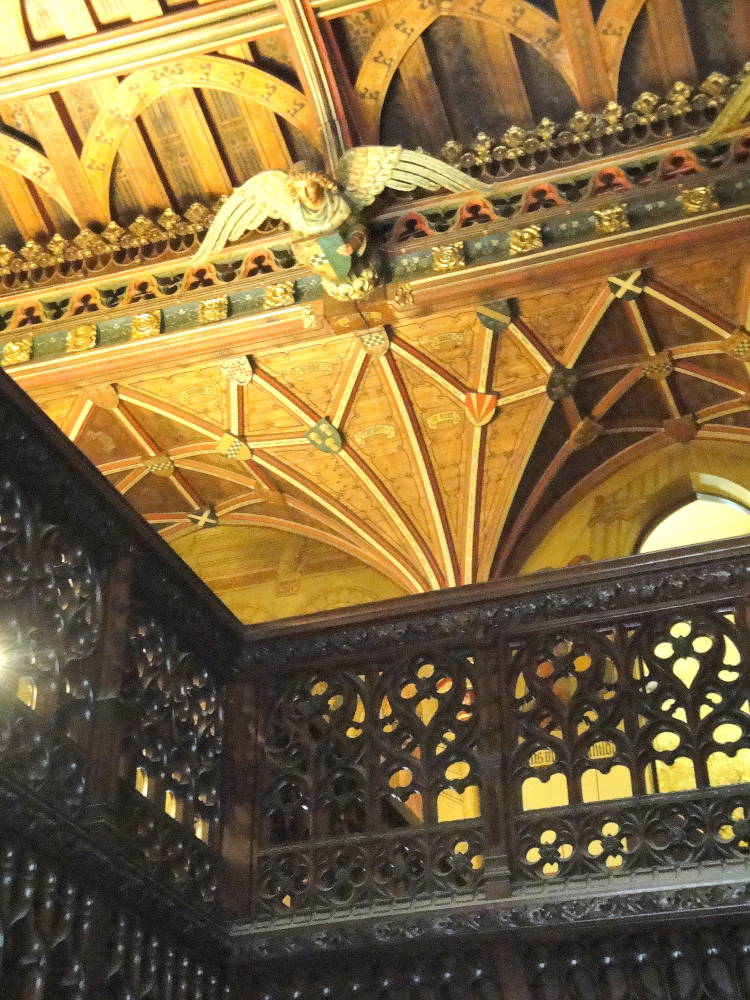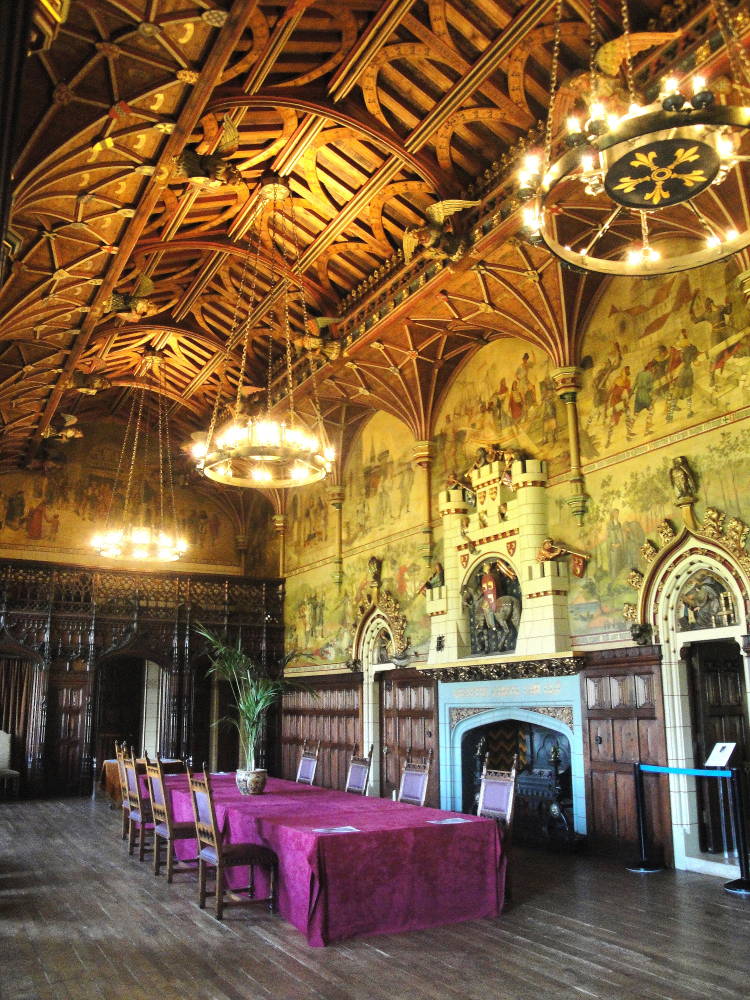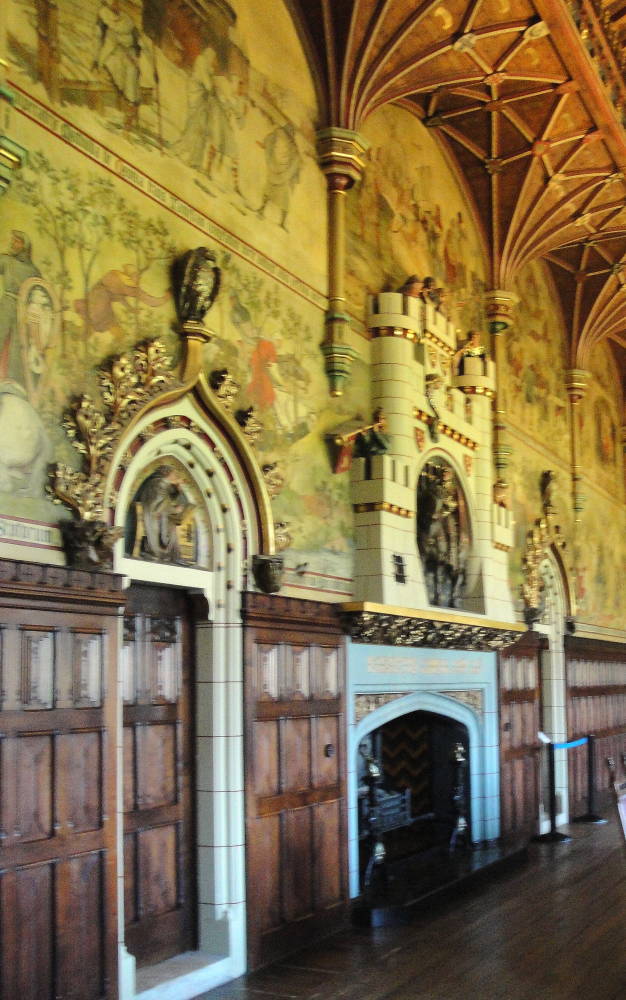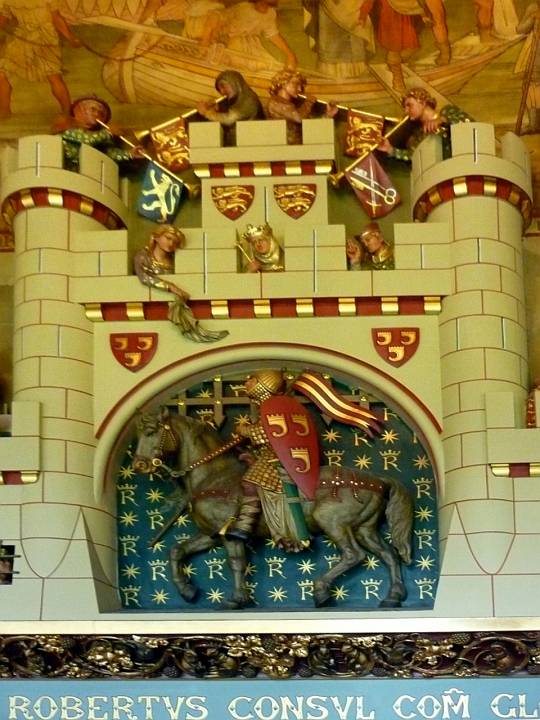Photographs by Banerjee and Robert Freidus. [Click on thumbnails for larger images.You may use these images without prior permission for any scholarly or educational purpose as long as you (1) credit the photographer and (2) link your document to this URL in a web document or cite the Victorian Web in a print one. ]
The Arab Room

Like the Winter Smoking Room, the Arab Room is located in a tower, this time in the Herbert Tower, which Burges built up from a sixteenth-century wing. While both the Summer and Winter Smoking Rooms were strictly male provinces, this was intended as a drawing room for the women. This may partly explain its harem feel. More importantly, however, Burges's early travels in Sicily and Constantinople had convinced him of the Moorish sources of medieval art; and recently both he and Lord Leighton had been inspired by Prisse d'Avennes's three-volume "exotic publication" with "gilded plates," L'Arte Arabe (1869-77; see Crook, William Burges, 275). Leighton's response was the Arab Hall of Leighton House, close to Burges's own Tower House in Kensington. Burges probably outdoes Leighton, though, in Cardiff Castle. The Arab Room is breathtaking, largely because of its extraordinarily rich ceiling, sometimes described in terms of a honeycomb. But there is intricately patterned carving everywhere, in various materials — from the cornice to the chairbacks to the marble panel over the fireplace. As a result, the room is arguably the apogee of Burges's work as an interior designer. He was still working on it in the months before he died, indeed, according to Crook he worked here on his very last visit to the castle (William Burges, 276). Appropriately enough, then, it is here that the Marquess paid tribute to his architect. Around the edges of the marble overmantel is carved in Latin, "John Marquess of Bute built this in 1881. William Burgess designed it." Burges died in the April of that year.
Ceiling Details



Fireplace, Walls, and Windows






Left to right: (a) The geometrically designed ceiling, shining with gold leaf. (b) A stained glass window / skylight casting a rich glow. (c) Part of the delicately carved cornice and frieze over the lower windows. Right: (d) Bute's and Burges's names carved around it (Burges's name, written GUILLIAMUS : BURGES, is on the right).
The Banqueting Hall

The Banqueting Hall and the Library are on the site of the old medieval hall. The larger spaces here come as something of a relief after the small rooms and narrow passageways of the castle's towers. In fact, in the Banqueting Hall the richness of the decor is absorbed to the extent that the room seems rather long and echoing. Its main glory is its wonderful hammerbeam roof, clearly inspired by church architecture, with its heraldry and angels.



Left to right: (a) A close-up of the ceiling shows carved angels holding shields and looking down over the hall. (b) Above one of the doorways, a monk works at his desk, while a wise owl crowns the archway above him.
The murals, here as elsewhere, were executed for Burges by H. W. Lonsdale, who had worked with him at St Fin Barre's Cathedral in Cork, and the huge chimneypiece was sculpted by another important member of Burges's team, Thomas Nicholls, who also carved the original animals on the Animal Wall. Both murals and chimneypiece recount the exploits of Robert the Consul, 1st Earl of Gloucester and 2nd Lord of Glamorgan, the nobleman credited with having built the Norman keep. The depictions of medieval life in the hall, such as the monk at his desk over one of the doorways, are delightful; and the chimneypiece with its splendidly colourful castle scene is very striking. Unfinished when Burges died, the wood-carving here was not completed until 1893 (see Crook, William Burges, 274). But the fact that the architect had assembled a strong team of craftsmen around him, including his assistant William Frame and both Lonsdale and the renowned interior decorators Crace & Son, meant that the work continued according to his plans and spirit.




Left to right: (a), (b), and (c) Three views of the Banqueting Hall. (d) Doorway and fireplace.



Left to right: (a)and (b) The central part of the chimneypiece depicts the twelfth-century Robert the Consul setting off on one of his exploits, gazing up at his wife as she waves her neckerchief from the ramparts; heralds blow their trumpets from the towers above them. (c) The Lady of the Castle holding the shield of her husband or lover in a quiet garden as tame deer and rabbits come to her.
The Top of Octagon stairs

: The head of the Octagon Tower staircase, with
a gilded crocodile lurking above the handrail.
Another tower, the Octagon Tower with its distinctive wooden spire, has the only Burges staircase in the castle — the grand one that he designed is now thought to have been built but later demolished (see Newman et. al. 202). The gilded crocodile on the Octagon Tower stairhead is a typically quirky detail, reminiscent of Lewis Carroll. At the top of this Tower is another small but lavishly decorated room, this time with a Chaucerean theme. But perhaps the pleasantest room of all is the Library, with its rich, warm tones. Here, part of the original Victorian heating system is skilfully hidden below a substantial wooden desk, behind decorative grilles. Burges drew up the designs for this in 1879, and the heating itself was installed by the pioneering heating engineer, Wilson Weatherley Phipson (see Roberts 42). The whole room looks used, and user-friendly. As usual, it contains some whimsical touches. Burges has a sly laugh at Darwin in the design around a doorway: while one monkey steals an apple from the Tree of Knowledge, another two have grabbed the Book Of Truth, and one of these is looking into it with great perplexity.
Other Views of Cardiff Castle and Related Material
- The castle exterior
- The Winter Smoking Room
- The Bachelor bedroom and bathroom (in the Clock Tower)
- The Summer Smoking Room
- The Library
- Lord Bute's Bedroom and Bath
- The Day Nursery
- The Roof Garden
Questions
1. Concluding his account of Burges's work here, J. Mordaunt Crook writes, "even with the great staircase, Cardiff Castle would still have been a series of dazzling episodes rather than a coherent programme. Architecturally and decoratively, each room is an autonomous unit, grafted on to — or hewn out of — a medieval structure." Crook describes such rooms as "fantasy capsules" (William Burges, 278), more exciting in their details than as a unified whole. How far do you agree with this verdict? Is some degree of "incoherence" inevitable in any kind of restoration? How do you distinguish between eclecticism and incoherence?
2. Compare Burges's work as an "art-architect" with Pugin's and Morris's (he particularly admired Pugin). What similarities can you find, and what differences? Burges certainly had his influence, not only through his work but also through his articles on church fittings and so on (e.g. see Muthesius 126, 154). But what factors enabled Morris, in the end, to reach a wider public?
3. Burges put much of his creative energies into Cardiff Castle and Castell Coch, clinging to the High Victorian style until the end. But the Cardiff building that had the most influence on architecture in the city and its suburbs was his much simpler Park House. Why do you think that was, and does this whole question of influence matter in evaluating an architect/designer's work (indeed, any artist's work in any medium)?
A Select Bibliography
Crook, J. Mordaunt. "Burges, William (1827-1881)." Oxford Dictionary of National Biography. Online ed. Viewed August 2009.
Crook, J. Mordaunt.The Dilemma of Style: Architectural Ideas from the Picturesque to the Post-Modern. Chicago: University of Chicago Press, 1987.
Crook, J. Mordaunt.William Burgess and the High Victorian Dream. London: Murray, 1981.
Long, Helen. The Edwardian House: The Middle-Class Home in Britain, 1880-1914. Manchester: Manchester University Press, 1993.
McLees, David. Castell Coch. Cardiff: Cadw (Crown Copyright), rev. ed. 2005.
Marsh, Jan. William Morris & Red House: A Collaboration between Architect and Owner. London: Anova Books, 2005.
Muthesius, Stefan. The High Victorian Movement in Architecture, 1850-1870. London: Routledge, 1972.
Newman, John, et al. Glamorgan (Buildings of Wales, Vol. 3). New Haven: Yale University Press, 1995.
Norwich, John Julius, ed. Treasures of Britain: The Architectural, Cultural, Historical and Natural Heritage of Britain. Windsor: AA/Everyman, 2002.
Williams, Matthew. William Burges, 1827-81. Andover, Hants: Jarrold Publishing (Pitkin Guide), 2007.
Last modified 9 November 2009